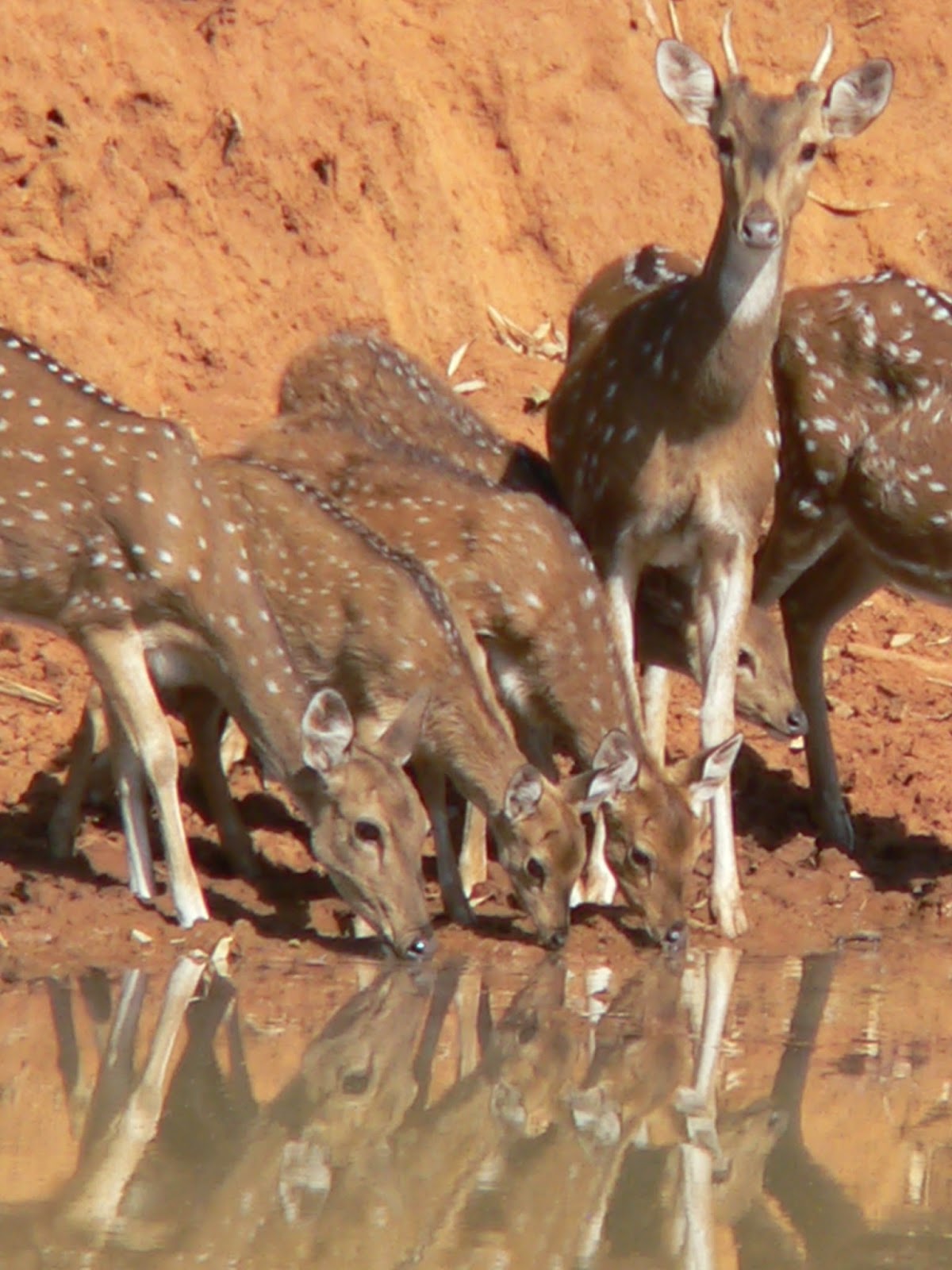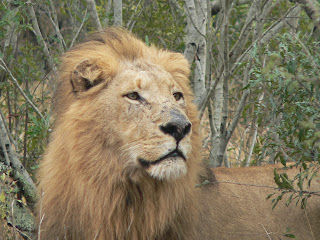Jabalpur is not exactly what you’d call an insignificant
hamlet. It has a population of over one
million. It sits smack bang in the
middle of the Indian sub-continent in the state of Madhya Pradesh. Apparently it doesn’t get many foreign
visitors because the Indians we met at our layover hotel in New Delhi didn’t
seem to have heard of it.
“Where are you going
next sir?”
“Jabalpur.” Puzzled expression.
“You are meaning
Jaipur sir?”
“No, not
Jaipur. Jabalpur. We’re flying to Jabalpur. There’s a national park near there –
Bandhavgarh National Park. We’re hoping
to see tigers.” This explanation did
nothing to dispel the puzzled looks.
“I do not know
either of these places sir.” I tried
again emphasising different syllables in the word Bandhavgarh. BANDhavgarh, BandHAVgarh, BandhavGARH. This elicited nothing but further puzzlement.
Bandhavgarh National Park scenery.
Anyway, the best way to get to Bandhavgarh is either a two
hour flight to Jabalpur from Mumbai or Delhi followed by a pleasant four hour
drive east north east, or an overnight train to Umaria which is an hour’s drive
from the National Park. I strongly
recommend the flight option, and this is how my wife Jacky and I got there. Our lodge – Jungle Mantra had organised an
air-conditioned car and a driver for our transfer from Jabalpur and despite the
cows, goats and dogs who all thought they had more right to be on the road than we
did we were delivered safely to our lodge where we were welcomed by Mr Ramji
the owner and his chef – Surindar, a smiling, chubby fellow dressed in chef’s
whites. Surindar shook our hands and
disappeared back into the kitchen from whence wonderful spicy smells
wafted towards us on the warm breeze.
We were then introduced to Toffee – a scorpion tailed yellow
dog of the type that you see all over Asia.
Mr Ramji explained in his middle class British accent that Toffee had
followed him home one day and stayed.
“She’s a good tiger
alarm.” He said. “She barks like mad
when she smells one and then runs to my house and hides under the bed.” Toffee looked up at him and squeaked in
affirmation. She squeaked quite a lot we
learned during our stay. She looked
earnestly at you and squeaked as if she was trying to tell you something, but
she never begged for food.
“When I took her to
Delhi for her rabies shot the vet asked me what sort of dog she was.” Said Mr
Ramji. “ I’ve no idea, I said.
The vet said he had to put the dog’s breed on the rabies vaccination
certificate. Country dog, he said. We’ll
just call her a country dog then shall we?"
Toffee the country dog
So we sat for a while in the shade of the open dining area,
chatted with Mr Ramji and stroked Toffee.
Hot, sweet masala chai was served, and delicious warm, newly baked
cookies. It was the first of April and
the afternoon was hot, but there were gusts of cooler air now and again that Mr
Ramji said were unseasonal. After a
while we were shown to our cabin, a spacious timber and bamboo structure with
an enormous, meticulously clean en-suite bathroom. There was a king sized bed with a mosquito
net canopy and a virtually silent air conditioner as well as ceiling fans.
Bandhavgarh sunset
Having slept for a couple of hours we wandered back to the
dining area just before sunset where we were met by Mr Ramji, Toffee and two
waiters. We were offered pre-dinner
drinks and delicious Indian snacks before being seated at the large mahogany
dining table overlooking the lodge grounds and the wooded hills of Bandhavgarh
National Park beyond. Two hours later we
waddled, stomachs bulging with delicious curries and naan bread back to our
cabin escorted by a security guard just in case we encountered something large
and stripy on the way.
Sambar deer.
The pleasant cool of dawn saw us making our first foray into
the national park itself in a four wheel drive open backed Suzuki Gypsy accompanied
by a driver hired by Mr Ramji, a government guide and Mr Ramji himself. This is Kipling country but the jungle of
Jungle Book fame is not the sort of jungle you’d expect. The word
jungle comes from the Hindi word jangle
which basically means an undeveloped
wooded area. We in the Western
Hemisphere would probably call it a forest.
There were large open meadows of tawny waist high grass, just right for
hiding a tiger. There were green swamps fed by tinkling rivulets of clear water and
big areas of open forests generously sprinkled with sal trees with their
luminous emerald green foliage. Then
there was the more closed forest where the middle distance was tantalisingly
locked away behind dense clumps of tall bamboo.
It was within an hour of setting off from the lodge that we encountered
our first tiger in one such area, but despite contorting ourselves into all kinds
of positions in the Gypsy all we could see were his rump and his legs through
the tangle of bamboo before he melted away. It was
frustrating, but we’d seen our first wild tiger and we still had the best part
of six days left of our safari.
Chital deer
Then on the fourth morning we arrived back at Jungle Mantra
Lodge after another tiger-less game drive to be met by two very excited
waiters. They said that toffee had been
barking all morning while we’d been in the national park. They’d gone out to investigate and found the
carcass of a cow in the grounds maybe eighty metres from our cabin. There were signs of a scuffle and dozens of
tiger pug marks in the dust. Mr Ramji
took us to see the carcass. There was
some flattened grass, but no bite marks on the beasts throat, perhaps it died
of fright, saving the tiger the trouble of making the kill. A few chunks of flesh were torn from the rump. The cat must have been disturbed or it would
have eaten far more. It was certainly
fresh, there was no smell.
Jacky and the cow carcass.
If I wanted to be funny I'd say the carcass is the one on the right,
but since I want to stay married I won't.
That night after dinner instead of waddling back to our
cabin, Jacky and I hauled our bulging bellies into the Gypsy where we were
joined by our regular driver Joseph, Mr Ramji, the two waiters, the security man
and Surindar still in his chef whites.
As paying guests we had the best seats while everyone else clung to whatever
part of the vehicle offered a foothold.
We drove out of the lodge grounds onto the dirt road that runs between
the low fence of the lodge and the three metre fence of the national park. The sharp barking alarm call of the sambar
deer had alerted Mr Ramji who guessed that the tiger must have come back to
finish the cow. We parked in the road,
in what Mr Ramji thought was the most likely spot that the tiger would
cross. The night was balmy and moonless
and the stars competed with satellites and fireflies for ascendancy.
A walk in the long grass can be interesting.
Surindar was in charge of the spotlight and he scanned the
bush with it with practiced ease as though tiger hunting was taught at every
catering college. Now and then his
movements prompted a gust of curry scented air to waft from his clothes. It mingled
with the sickly sweet aroma of fallen yellow mahua fruit that had been mashed under the wheels of vehicles including our own. Every morning we’d see women and children
from the village collecting this fruit in baskets by the side of the road. Mr Ramji said they’d go out at about four in
the morning, braving tigers, leopards and traffic to collect the fruit and make
it into a potent alcoholic brew.
Egyptian vultures.
We’d been sitting in the Gypsy for about forty five minutes. “There, there! It’s coming, it’s coming, it’s
coming!” Hissed Mr Ramji. He was mildly excited to say the least. Surindar swung his spotlight and there on the
other side of the lodge fence was a tigress.
What a beautiful creature, so lithe and athletic and so supremely
confident in her own skin. She hopped
over the fence as though it didn’t exist not twenty metres from where we sat,
her intricate orange and black markings glowing in Surindar’s spotlight. She ambled across the road making soft, staccato,
guttural calls as she went. Somewhere
inside the national park the Sambar deer were filling the night with their
alarm calls. Surindar swung the light
away from the tigress to the park fence.
There on the other side was a miniature version of the tigress – her cub,
less than half her size and less than a year old. The tigress sprang over the three metre fence
of the national park without touching it and landed softly on the other side,
greeting her cub with gentle head rubs.
After a moment they sidled off together into the darkness and soon the
only evidence that they had been there at all was the ever more frantic barking
of the deer.
Over the next two or three days in the national park we photographed
a total of four more tigers, as clear as you like, in broad daylight, walking,
drinking, sitting, laying down, you name it, but we still think that our own
Jungle Mantra tiger was the best, and we hadn’t even managed to get a photo of
her. It doesn’t matter a jot though. She's
imprinted on our memory forever and that’s what’s important.
Visit the Jungle Mantra website here. http://www.junglemantra.com/default.htm
Interested in visiting India, Africa or any other wildlife destination? Call me – Peter Emery on 0449 689 447 or drop
me an email. peter.emery@ucango.com.au
More Bandhavgarh scenery.




































